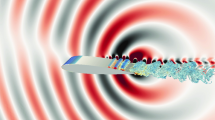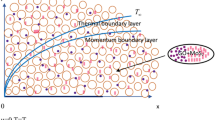Abstract
The cycle-to-cycle variations (CCV) of in-cylinder flow make critical impact on internal combustion engine performance. The flow structure evolution and its cyclic variations need to be fully understood. In this study, a novel approach which couples proper orthogonal decomposition (POD) and dynamic mode decomposition (DMD) is proposed to identify the CCV features of in-cylinder flow under various swirl conditions. The methodology is applied to a time-resolved high-speed particle image velocimetry (PIV) dataset which measures the crank angle resolved flow field on a swirl plane 30 mm below the injector tip in the cylinder. Phase-invariant POD and DMD analyses are conducted on 121 phase angles which cover the majority of in-cylinder flow evolution stroke from -300 crank angle degree (CAD) after top dead center (TDC) to -60 CAD after TDC with a 2-CAD resolution. The modal decomposition analyses are applied on 100 engine cycles individually to investigate the cyclic variation. Phase-invariant POD identifies the steady structure and coherent structure of the in-cycle engine flow evolution features. A novel stepwise traversal correlation search method (STCSM) is proposed to connect the DMD modes with POD decomposed coherent structure. This analysis approach is capable of identifying the characteristic frequencies and correlating them with the dynamical decay rates of underlying flow coherent structures with regards to CCV. In summary, the CCV of dynamical features for all swirl ratio conditions show similar variation level at intake stroke. Inducing a higher swirl ratio can minimize the effect of intake flow dynamics and suppress the cyclic variability of engine flow at compression stroke.


















Similar content being viewed by others
Data availability
All data are available upon request.
References
Ameen, M.M., Yang, X., Kuo, T.W., Som, S.: Parallel methodology to capture cyclic variability in motored engines. Int. J. Engine Res. 18(4), 366–377 (2017). https://doi.org/10.1177/1468087416662544
Bode, J., Schorr, J., Krüger, C., Dreizler, A., Böhm, B.: Influence of the in-cylinder flow on cycle-to-cycle variations in lean combustion DISI engines measured by high-speed scanning-PIV. Proc. Combust. Inst. 37(4), 4929–4936 (2019). https://doi.org/10.1016/j.proci.2018.07.021
Bode, J., Schorr, J., Krüger, C., Dreizler, A., Böhm, B.: Influence of three-dimensional in-cylinder flows on cycle-to-cycle variations in a fired stratified DISI engine measured by time-resolved dual-plane PIV. Proc. Combust. Inst. 36(3), 3477–3485 (2017). https://doi.org/10.1016/j.proci.2016.07.106
Brunton, S.L., Kutz, J.N.: Data-driven science and engineering: machine learning, dynamical systems, and control. Cambridge University Press, Cambridge (2019)
Calmet, H., Pastrana, D., Lehmkuhl, O., Yamamoto, T., Kobayashi, Y., Tomoda, K., Houzeaux, G., Vázquez, M.: Dynamic mode decomposition analysis of high-fidelity CFD simulations of the sinus ventilation. Flow Turbul. Combust. 105(3), 699–713 (2020). https://doi.org/10.1007/s10494-020-00156-8
Chen, H., Xu, M., Hung, D.L.S.: Analyzing in-cylinder flow evolution and variations in a spark-ignition direct-injection engine using phase-invariant proper orthogonal decomposition technique. In: WCX World Congress Experience, pp. 01–1174. SAE International, Detroit, MI (2014). https://doi.org/10.4271/2014-01-1174
Cosadia, I., Borée, J., Dumont, P.: Coupling time-resolved PIV flow-fields and phase-invariant proper orthogonal decomposition for the description of the parameters space in a transparent diesel engine. Exp. Fluids. 43(2–3), 357–370 (2007). https://doi.org/10.1007/s00348-007-0338-7
Deng, B., Chen, Y., Hou, K., Fu, J., Feng, R.: An experimental and numerical investigation on cycle-to-cycle variation of three different displacements single-cylinder motorcycle engines: the sequential analysis from intake to flame propagation process. Fuel 275, 117945 (2020). https://doi.org/10.1016/j.fuel.2020.117945
Dong, X., Yang, J., Chan, Q.: Influence of flash boiling and swirl ratio on the gasoline spray structure in a spark-ignition optical engine: an experimental study. J. Energy Inst. 94, 233–241 (2021). https://doi.org/10.1016/j.joei.2020.09.007
Dreher, D., Schmidt, M., Welch, C., Ourza, S., Zündorf, S., Maucher, J., Peters, S., Dreizler, A., Böhm, B., Hanuschkin, A.: Deep feature learning of in-cylinder flow fields to analyze cycle-to-cycle variations in an SI engine. Int. J. Engine Res. 22(11), 3263–3285 (2021). https://doi.org/10.1177/1468087420974148
Fogleman, M., Lumley, J., Rempfer, D., Haworth, D.: Application of the proper orthogonal decomposition to datasets of internal combustion engine flows. J. Turbul. 5, N23 (2004). https://doi.org/10.1088/1468-5248/5/1/023
Hanuschkin, A., Schober, S., Bode, J., Schorr, J., Böhm, B., Krüger, C., Peters, S.: Machine learning–based analysis of in-cylinder flow fields to predict combustion engine performance. Int. J. Engine Res. 22(1), 257–272 (2021). https://doi.org/10.1177/1468087419833269
Li, C.Y., Tse, T.K.T., Hu, G.: Dynamic mode decomposition on pressure flow field analysis: flow field reconstruction, accuracy, and practical significance. J. Wind. Eng. Ind. Aerodyn. 205, 104278 (2020). https://doi.org/10.1016/j.jweia.2020.104278
Li, W., Li, Y., Wang, T., Jia, M., Che, Z., Liu, D.: Investigation of the effect of the in-cylinder tumble motion on cycle-to-cycle variations in a direct injection spark ignition (DISI) engine using large eddy simulation (LES). Flow Turbul. Combust. 98(2), 601–631 (2017). https://doi.org/10.1007/s10494-016-9773-y
Liu, K., Haworth, D.C., Yang, X., Gopalakrishnan, V.: Large-eddy simulation of motored flow in a two-valve piston engine: POD analysis and cycle-to-cycle variations. Flow Turbul. Combust. 91(2), 373–403 (2013). https://doi.org/10.1007/s10494-013-9475-7
Liu, K., Haworth, D.C.: Development and assessment of POD for analysis of turbulent flow in piston engines. In: WCX World Congress Experience, pp. 01–0830. SAE International, Detroit, MI (2011). https://doi.org/10.4271/2011-01-0830
Liu, M., Zhao, F., Li, X., Xu, M., Hung, D.L.S.: Dynamic mode decomposition for extracting cycle-to-cycle variation of sidi engine in-cylinder flow under motoring condition. In: Proceedings of the ASME 2020 Internal Combustion Engine Division Fall Technical Conference. Virtual, Online. November 4–6, 2020. V001T06A003. ASME. https://doi.org/10.1115/ICEF2020-2917
Lumley, J.: The structure of inhomogeneous turbulence, atmospheric turbulence and wave propagation, pp. 166–178. AM Yaglom, VI Tatarski (1967)
Masouleh, M.G., Keskinen, K., Kaario, O., Kahila, H., Wright, Y.M., Vuorinen, V.: Flow and thermal field effects on cycle-to-cycle variation of combustion: scale-resolving simulation in a spark ignited simplified engine configuration. Appl. Energy. 230, 486–505 (2018). https://doi.org/10.1016/j.apenergy.2018.08.046
Nguyen, D., Wu, P., Monico, R.O., Chen, G.: Dynamic mode decomposition for large-scale coherent structure extraction in shear flows. IEEE Trans. vis. Comput. Graph. (2021). https://doi.org/10.1109/TVCG.2021.3124729
Ozdor, N., Dulger, M., Sher, E.: Cyclic variability in spark ignition engines a literature survey. SAE transactions pp. 1514–1552 (1994). https://doi.org/10.4271/940987
Qin, W., Zhou, L., Liu, D., Jia, M., Xie, M.: Investigation of in-cylinder engine flow quadruple decomposition dynamical behavior using proper orthogonal decomposition and dynamic mode decomposition methods. ASME. J. Eng. Gas Turbines Power. 141(8), 081004 (2019). https://doi.org/10.1115/1.4042725
Reitz, R.D., Ogawa, H., Payri, R., Fansler, T., Kokjohn, S., Moriyoshi, Y., Agarwal, A., Arcoumanis, D., Assanis, D., Bae, C., Boulouchos, K., Canakci, M., Curran, S., Denbratt, I., Gavaises, M., Guenthner, M., Hasse, C., Huang, Z., Ishiyama, T., Johansson, B., Johnson, T.V., Kalghatgi, G., Koike, M., Kong, S.C., Leipertz, A., Miles, P., Novella, R., Onorati, A., Richter, M., Shuai, S., Siebers, D., Su, W., Trujillo, M., Uchida, N., Vaglieco, B.M., Wagner, R.M., Zhao, H.: IJER editorial: the future of the internal combustion engine. Int. J. Engine Res. 21(1), 3–10 (2020). https://doi.org/10.1177/1468087419877990
Roudnitzky, S., Druault, P., Guibert, P.: Proper orthogonal decomposition of in-cylinder engine flow into mean component, coherent structures and random gaussian fluctuations. J. Turbul. 7, N70 (2006). https://doi.org/10.1080/14685240600806264
Rowley, C.W., Mezić, I., Bagheri, S., Schlatter, P., Henningson, D.: Spectral analysis of nonlinear flows. J. Fluid Mech. 641, 115–127 (2009). https://doi.org/10.1017/S0022112009992059
Rulli, F., Fontanesi, S., d’Adamo, A., Berni, F.: A critical review of flow field analysis methods involving proper orthogonal decomposition and quadruple proper orthogonal decomposition for internal combustion engines. Int. J. Engine Res. 22(1), 222–242 (2021). https://doi.org/10.1177/1468087419836178
Sadeghi, M., Truffin, K., Peterson, B., Böhm, B., Jay, S.: Development and application of bivariate 2D-EMD for the analysis of instantaneous flow structures and cycle-to-cycle variations of in-cylinder flow. Flow Turbul. Combust. 106(1), 231–259 (2021). https://doi.org/10.1007/s10494-020-00197-z
Schmid, P.J.: Dynamic mode decomposition of numerical and experimental data. J. Fluid Mech. 656, 5–28 (2010). https://doi.org/10.1017/S0022112010001217
Shen, L., Teh, K.Y., Ge, P., Zhao, F., Hung, D.L.S.: Temporal evolution analysis of in-cylinder flow by means of proper orthogonal decomposition. Int. J. Engine Res. 22(5), 1714–1730 (2021). https://doi.org/10.1177/1468087420917246
Shin, J., Kim, D., Son, Y., Park, S.: Effects of swirl enhancement on in-cylinder flow and mixture characteristics in a high-compression-ratio, spray-guided, gasoline direct injection engine. Case Stud. Therm. Eng. 34, 101937 (2022). https://doi.org/10.1016/j.csite.2022.101937
Sirovich, L.: Turbulence and the dynamics of coherent structures. II. symmetries and transformations. Q. Appl. Math. 45(3), 573–582 (1987). https://doi.org/10.1090/qam/910463
Soltau, J.P., Eng, B.: Cylinder pressure variations in petrol engines. Proc. Inst. Mech. Eng.: Automob. Div. 14(1), 99–117 (1960). https://doi.org/10.1243/PIME_AUTO_1960_000_014_02
Taira, K., Brunton, S.L., Dawson, S.T.M., Rowley, C.W., Colonius, T., McKeon, B.J., Schmidt, O.T., Gordeyev, S., Theofilis, V., Ukeiley, L.S.: Modal analysis of fluid flows: an overview. AIAA J. 55(12), 4013–4041 (2017). https://doi.org/10.2514/1.J056060
Taira, K., Hemati, M.S., Brunton, S.L., Sun, Y., Duraisamy, K., Bagheri, S., Dawson, S.T.M., Yeh, C.: Modal analysis of fluid flows: applications and outlook. AIAA J. 58(3), 998–1022 (2020). https://doi.org/10.2514/1.J058462
Tu, J.H., Rowley, C.W., Luchtenburg, D.M., Brunton, S.L., Kutz, J.N.: On dynamic mode decomposition: theory and applications. J. Comput. Dyn. 1(2), 391–421 (2014). https://doi.org/10.3934/jcd.2014.1.391
Van Dam, N., Rutland, C.: Understanding in-cylinder flow variability using large-eddy simulations. ASME. J. Eng. Gas Turbines Power. 138(10), 102809 (2016). https://doi.org/10.1115/1.4033064
Van Dam, N., Sjöberg, M., Som, S.: Large-eddy simulations of spray variability effects on flow variability in a direct-injection spark-ignition engine under non-combusting operating conditions. In: WCX World Congress Experience, pp. 01–0196. SAE International, Detroit, MI (2018). https://doi.org/10.4271/2018-01-0196
Wang, T., Li, W., Jia, M., Liu, D., Qin, W., Zhang, X.: Large-eddy simulation of in-cylinder flow in a DISI engine with charge motion control valve: proper orthogonal decomposition analysis and cyclic variation. Appl. Therm. Eng. 75, 561–574 (2015). https://doi.org/10.1016/j.applthermaleng.2014.10.081
Wang, Y., Hung, D.L.S., Zhuang, H., Xu, M.: Cycle-to-cycle analysis of swirl flow fields inside a spark-ignition direct-injection engine cylinder using high-speed time-resolved particle image velocimetry. In: WCX World Congress Experience, pp. 01–0637. SAE International, Detroit, MI (2016). https://doi.org/10.4271/2016-01-0637
Willman, C., Scott, B., Stone, R., Richardson, D.: Quantitative metrics for comparison of in-cylinder velocity fields using particle image velocimetry. Exp. Fluids. 61(2), 62 (2020). https://doi.org/10.1007/s00348-020-2897-9
Yang, J., Dong, X., Wu, Q., Xu, M.: Effects of enhanced tumble ratios on the in-cylinder performance of a gasoline direct injection optical engine. Appl. Energy. 236, 137–146 (2019). https://doi.org/10.1016/j.apenergy.2018.11.059
Yang, J., Xu, M., Hung, D.L.S., Wu, Q., Dong, X.: Influence of swirl ratio on fuel distribution and cyclic variation under flash boiling conditions in a spark ignition direct injection gasoline engine. Energy Convers. Manage. 138, 565–576 (2017). https://doi.org/10.1016/j.enconman.2017.02.024
Yang, X., Kuo, T.: Correlation of CCV between in-cylinder swirl ratio and polar velocity profile in valve seat region using LES under motored engine condition. Oil Gas Sci. Technol. 72(6), 38 (2017). https://doi.org/10.2516/ogst/2017036
Zhao, F., Ge, P., Zhuang, H., Hung, D.L.S.: Analysis of crank angle-resolved vortex characteristics under high swirl condition in a spark-ignition direct-injection engine. ASME. J. Eng. Gas Turbines Power. 140(9), 092807 (2018). https://doi.org/10.1115/1.4039082
Zhao, F., Hung, D.L.S., Wu, S.: K-means clustering-driven detection of time-resolved vortex patterns and cyclic variations inside a direct injection engine. Appl. Therm. Eng. 180, 115810 (2020). https://doi.org/10.1016/j.applthermaleng.2020.115810
Zhuang, H., Hung, D.L.S.: Characterization of the effect of intake air swirl motion on time-resolved in-cylinder flow field using quadruple proper orthogonal decomposition. Energy Convers. Manage. 108, 366–376 (2016). https://doi.org/10.1016/j.enconman.2015.10.080
Acknowledgements
The experiments were carried out at the National Engineering Laboratory for Automotive Electronic Control Technology of the Shanghai Jiao Tong University. The authors gratefully appreciate the experimental support by Prof. Min Xu and Prof. Xuesong Li of Shanghai Jiao Tong University.
Author information
Authors and Affiliations
Corresponding author
Ethics declarations
Conflict of interest
The authors declare that they have no conflict of interest.
Additional information
Publisher's Note
Springer Nature remains neutral with regard to jurisdictional claims in published maps and institutional affiliations.
Rights and permissions
Springer Nature or its licensor holds exclusive rights to this article under a publishing agreement with the author(s) or other rightsholder(s); author self-archiving of the accepted manuscript version of this article is solely governed by the terms of such publishing agreement and applicable law.
About this article
Cite this article
Liu, M., Zhao, F. & Hung, D.L.S. A coupled phase-invariant POD and DMD analysis for the characterization of in-cylinder cycle-to-cycle flow variations under different swirl conditions. Flow Turbulence Combust 110, 31–57 (2023). https://doi.org/10.1007/s10494-022-00348-4
Received:
Accepted:
Published:
Issue Date:
DOI: https://doi.org/10.1007/s10494-022-00348-4




